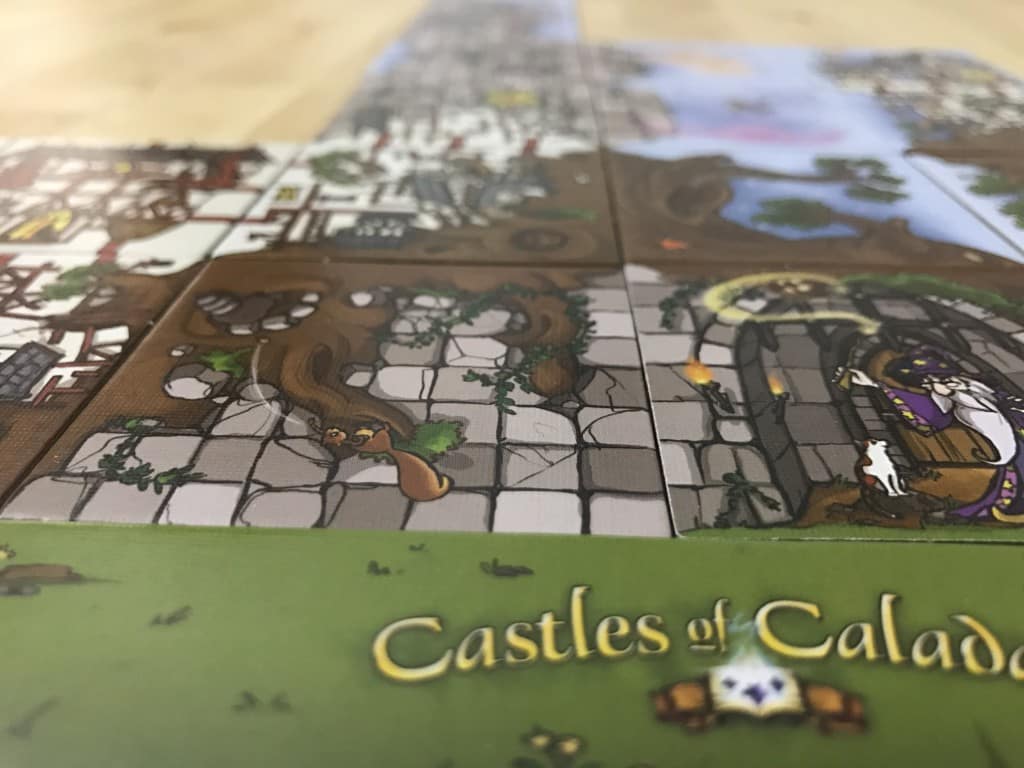Who doesn’t like a good tile laying game? Since the birth of the Meeple, tile draw and placement have been staples of the hobby, bookending games like Carcassonne, Tigris & Euphrates, and Alhambra, to name just a few award winners in the category. There’s something distinctly satisfying about pulling a tile or drafting it from a tableau and finding a way to wedge it into your personal tableau.
So I was excited when I received Castles of Caladale, a new release from designer David Wilkinson and Renegade Games hitting store shelves this spring. The game promised relatively simple, accessible tile laying tableau building for 1-4 players, and it more than delivers. From the whimsical theme and charming illustrations to the simple yet engrossing mechanics, the game manages to make a gaming staple feel fresh and fun in a quick, accessible package.
How Castles of Caladale Plays
Castles of Caladale is a very simple game. There are a handful of ways to increase difficulty (mostly by limiting the time available to players to make selections), but the game at its core is as easy as it gets – with only one page of actual rules in the book.
Every player starts with a base and a starting tile. Their starting tile is two-sided – one side featuring a single building type and the other a mix of two. A board is setup with 9 spaces and you’ll stack up all the available tiles in the game (of which there are quite a few, not all of which you will use in a 1-2 player game).
The board remains full of 9 tiles and players must choose them one at a time. When you choose a tile, you do one of two things with it. You either flip it face down and place it aside for 1 guaranteed point, or you place it in your tableau. There are three building types that might appear on the tiles, as well as sky. You must match up the edges of your tiles and complete a castle with as few open edges as possible.
Scoring is equally simple. At the end of the game you receive 2 points for every tile in your castle, bonus points for flags at the top of your castle and 1 point each for the tiles you set aside as unused. Most importantly, you will LOSE two points for every open edge in your castle. This means a single poorly placed tile could be -6 points if all sides are open. The catch? You can rearrange your castle at any time, including at the end before scoring. You cannot, however, take tiles out of your castle. If you took a tile for the castle, it stays there, in whatever position you decide to place it.
The game comes with a 30 second timer to speed people along if they start to take too long rearranging their castle, and there are a handful of variants using that timer. But for the most part, you have a 20 minute game of taking and placing tiles in your tableau.
What We Like About Castles of Caladale
This is a great little game. What at first seemed almost too simple has as surprising amount of depth to it. By removing the permanent placement rule of most tile laying games, you actually open up a fair amount of strategy.
Do I take this tile and put it in my castle anyways, knowing that I might not be able to close it off? Or do I bit the bullet and flip it for less points? Should I take more stone tiles so I have space to grow for that building material?
These are the questions you’ll ask as you draft the tiles, and the more players there are, the more you’ll have to think about these things carefully to avoid leaving yourself in a bad position.
The fact that the game is completely language independent, takes only 20-30 minutes, and guarantees a different layout every time you play only help to make it that much more fun and accessible, especially for young players and families. As a finishing touch, the game comes with a cute storybook at the back of the rule book and a slip cover to showcase the cover artwork, evoking the storybook feel of the theme.
What We Don’t Like About Castles of Caladale
There aren’t a lot of issues here. Castles of Caladale is not a heavy game, nor is it designed to be, but at the same time, it manages to integrate enough clever things to keep it engaging for everyday gamers.
One thing you will need, however, is a lot of space. Castles can sprawl in any direction and may run into each other relatively early in the game, especially in 2 or 3 player games when you are using maximum tiles. This isn’t a bad thing (if anything, it makes it more fun), but it’s something to be aware of before you get boxed out on a small table.
The Bottom Line
Castles of Caladale isn’t the type of game I typically gravitate towards. It is quick, simple and generally not overly strategic, and yet I find myself liking it quite a bit. That simple and yet always satisfying tile laying and matching mechanic works so well here, and the finished castle you end up with is almost always worth taking a picture of.
This game is a borderline play to buy for me depending on the audience. If you primarily play heavy euros and are looking for something quick and accessible for downtime, it may not scratch the exact itch you are looking for, but if you play with newer gamers, have a family, or just like tile laying games like I do, it’s worth picking up.
SCORE
8.0
Buy
REVIEW
8

